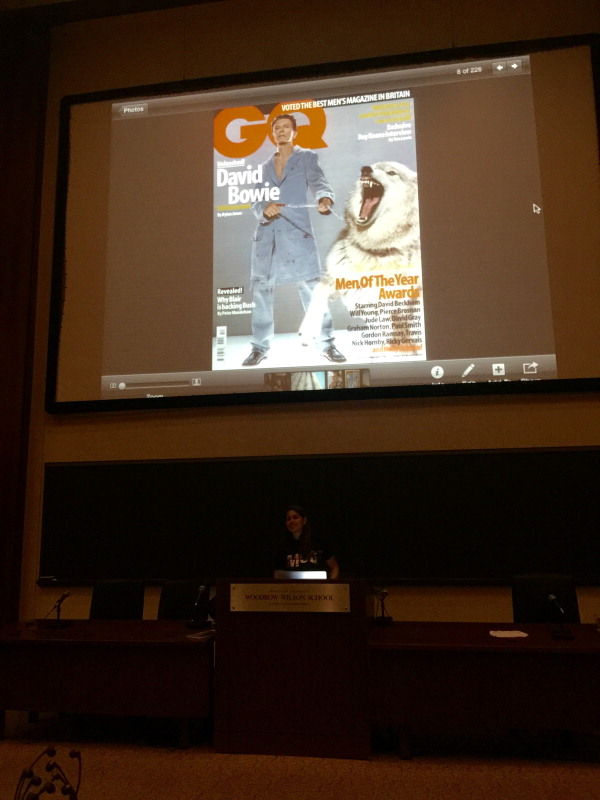By Nathan Phan, Special Writer
For creators of every kind, including herself, award-winning photographer and director Indrani Pal-Chaudhuri said they’re always striving for that combination of fantasy and reality, to find an intersection between the two that is actually more real than the everyday reality.
Ms. Pal-Chaudhuri was one of the several guest speakers at the REACH conference organized by AdThis, Princeton University’s marketing and advertising club. Held at Dodds Auditorium on April 2, the REACH conference brought advertising and marketing experts to the Princeton community in hopes of showing the inner workings in creating an advertisement.
Featured speakers included Jeff Kling, who helped created “The Most Interesting Man in The World” ad for Dos Equis beer, and John McKelvey and Hannes Ciatti, the creative directors of Under Armour’s “I Will What I Want” campaign.
A 2001 Princeton graduate, Ms. Pal-Chaudhuri — more commonly known by her first name Indrani — took on a variety of roles before becoming a photographer, working as a model at 14 and co-founding the school Shakti Empowerment Education Foundation at age 18. Although she continued to develop her skills as a photographer, Ms. Pal-Chaudhuri’s photography career really jumpstarted when she came to Princeton, especially after the late rocker David Bowie noticed her work and asked her to photograph for him.
Working on the cover of Bowie’s album “Heathen” and Bowie’s photo shoot as GQ Magazine’s Man of the Year in 1997, Ms. Pal-Chaudhuri would later have her start as a video director when directing Bowie’s music video “Valentine’s Day.” Working with Mr. Bowie helped launch Ms. Pal-Chaudhuri into the photography industry, and since then she has worked with a number of celebrities, including Mariah Carey, Kim Kardashian and Beyoncé.
At the beginning of her talk, Ms. Pal-Chaudhuri explained her interest in talking about the idea of celebrities as icons.
“I wanted to take a look together at what it takes to create an icon — what’s the difference between a great singer and someone who embodies a much larger vision of our times,” she said.
In light of Bowie’s recent death, Ms. Pal-Chaudhuri shared his readiness to challenging ideas of photography and image-making at the time and expressed how fortunate she was in having Mr. Bowie as a mentor early on in her career. She described how he was able to transform into different personas yet still maintain his own authenticity.
“That’s what the interesting thing about Bowie as an icon — that he really represented pushing oneself to one’s limits,” said Ms. Pal-Chaudhuri. “He’s one of the rare artists who has transformed so dramatically and yet there’s no question about his authenticity — he’s incredibly real at the same time.”
Hoping to empower a female audience into the world of athleticism, Under Armour’s “I Will What I Want” campaign also featured iconic individuals who defied societal standards, including professional ballerina Misty Copeland and supermodel Gisele Bündchen. Both Mr. McKelvey and Mr. Ciatti recognized the need to break the barrier in Under Armour’s advertising, which initially discouraged a female audience.
“ ‘I Will What I Want’ was created specifically to change the perception of uber-masculine men by celebrating all women who defied expectations and ignoring the noise of outside judgment,” said Mr. McKelvey.
Despite not being initially familiar to the campaign’s subject matter, Mr. McKelvey and Mr. Ciatti underwent what Mr. Ciatti called “a deep dive into culture,” learning about the relationships between women and fitness or fashion trends and understanding the conflicting social pressures placed upon women. This research gave them the necessary foundation in building their work on a cultural truth and insight and developing their manifesto for the “I Will What I Want” campaign.
“The biggest take away that we had of all this research was contradicting opinions being forced onto women about how they should live their lives, these pressures from society to be all things to all people,” said Mr. Ciatti. “But the only way through the conflicting opinions is just to do you — you don’t need anyone permission when you have will and your own strength.”
In developing the campaign, Mr. McKelvey and Mr. Ciatti helped create video advertisements that showcased women facing obstacles but ultimately overcoming them. Ms. Copeland’s video, which touched upon her childhood rejection as a ballerina because of her body type and age, became a viral sensation in its initial release and has garnered more than 10 million views on YouTube. Combining both vulnerability and empowerment, these video advertisements have broadened Under Armour’s audience to both men and women.
Many of the speakers at the REACH conference emphasized how successful advertisements are those that establish a clear communication with their audiences.
“When communication is really successful, I think it’s because it taps into some kind of deeper truth that people feel and connect with,” said Ms. Pal-Chaudhuri.

